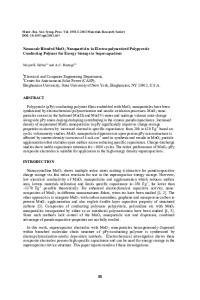Proton conducting polymer electrolyte based on cornstarch, PVP, and NH 4 Br for energy storage applications
- PDF / 762,304 Bytes
- 13 Pages / 595.276 x 790.866 pts Page_size
- 98 Downloads / 287 Views
ORIGINAL PAPER
Proton conducting polymer electrolyte based on cornstarch, PVP, and NH4Br for energy storage applications M. Anandha Jothi 1,2 & D. Vanitha 1,2 & S. Asath Bahadur 1,3 & N. Nallamuthu 1,2 Received: 20 April 2020 / Revised: 22 August 2020 / Accepted: 21 September 2020 # Springer-Verlag GmbH Germany, part of Springer Nature 2020
Abstract Proton conducting polymer blend electrolytes based on cornstarch and polyvinyl pyrrolidone (PVP) with ammonium bromide (NH4Br) were prepared by the technique of solution casting. Enhancement of amorphous nature by the addition of NH4Br has confirmed by XRD. In FTIR,by the addition of NH4Br salt in the optimized blend system, there occurs a change like altering the peak intensity, peak shape, and position. This reveals the appearance of complex formation between the polymer and salt. At 358 K, 30 wt.% of NH4Br added system shows the maximum conductivity (1.31 × 10−4 S cm−1). The conduction mechanism of higher conducting polymer blend electrolytes follows the quantum mechanical tunneling (QMT) at mid-frequency and overlapping large polaron tunneling (OLPT) at higher frequency. High dielectric constant and low relaxation time of ions in polymer chain are obtained for 30 wt.% of NH4Br added polymer blend electrolyte. From Wagner’s polarization technique, it is established that conduction present in the polymer electrolytes is predominately due to ions. Faradaic pseudo capacity behaviour has observed in higher conducting sample by cyclic voltammetry. The electrochemical cell has prepared by the higher conducting polymer electrolyte and the open circuit potential (OCP) of 1.24 V has achieved from prepared electrochemical cell. Keywords FTIR . Polymer electrolytes . Proton conductors . Electrochemical characterizations . Ionic conductivities
Introduction Recently, both academia and industrial researchers have focused great attention in the interdisciplinary field of polymer electrolytes which includes the discipline of polymer physics, electrochemistry, organic chemistry, and inorganic chemistry for the new electrochemical devices (batteries, super capacitors, fuel cells, solar cells, sensors, etc.). It has created revolutionize in many industrial areas [1–5]. Solid polymer electrolyte (SPE) has more advantages due to its excellent electrode
* D. Vanitha [email protected] 1
Department of Physics, School of Advanced Science (SAS), Kalasalingam Academy of Research and Education, Krishnankoil, Srivilliputhur 626 126, India
2
Multifunctional Materials Laboratory, International Research Centre, Kalasalingam Academy of Research and Education, Krishnankoil, Srivilliputhur 626 126, India
3
Condensed Matter Physics Laboratory, International Research Centre, Kalasalingam Academy of Research and Education, Krishnankoil, Srivilliputhur 626 126, India
and electrolyte interface contact, no leakage problem, high safety, good mechanical, and adhesive properties [6–10]. In worldwide, the biodegradable polymers have enormous attention for avoiding environmental polluting chemical
Data Loading...











